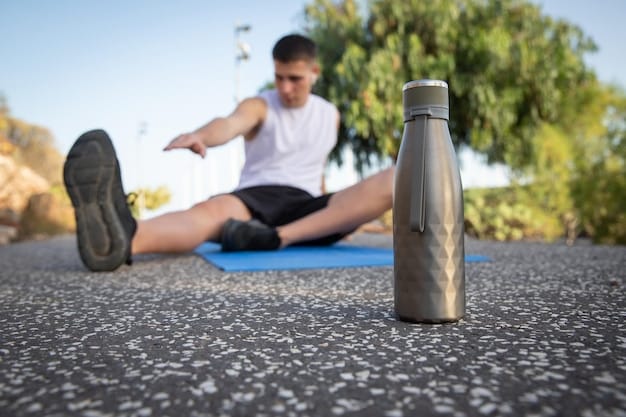Post-Workout Recovery: Optimize Muscle Repair Strategies

Post-workout recovery is essential for muscle repair, growth, and overall athletic longevity, involving a strategic combination of nutrition, rest, and active regeneration techniques to optimize physical adaptation and performance.
After pushing your body to its limits during a challenging workout, the real work of repair and growth begins. Neglecting post-exercise care can undermine your efforts, hindering progress and increasing injury risk. Learning how to truly optimize your routine ensures every session contributes meaningfully to your fitness goals. This article delves into the critical strategies for Post-Workout Recovery: Optimize Muscle Repair with These Strategies, ensuring you maximize gains and maintain peak performance.
The Science Behind Post-Workout Recovery
Understanding recovery is not merely about resting; it is an intricate biological process where the body adapts and rebuilds stronger. When you exercise, especially intensely, you create micro-tears in muscle fibers and deplete energy stores. Recovery is the period where these fibers are repaired, and energy reserves are replenished, leading to adaptation and improved performance in subsequent sessions.
This process is far from passive. It involves a cascade of hormonal and cellular responses aimed at restoring homeostasis and supercompensating for the stress endured. Ignoring these signals can lead to overtraining, diminished returns, and a higher propensity for injury. Therefore, a strategic approach to recovery is as crucial as the training itself.
Cellular Repair and Muscle Protein Synthesis
At the microscopic level, exercise-induced muscle damage triggers an inflammatory response, which is a necessary part of the healing process. Following this, satellite cells, a type of stem cell, are activated. They proliferate, migrate to the damaged area, and fuse with existing muscle fibers to facilitate repair and growth. This process is known as muscle protein synthesis (MPS).
MPS is heavily influenced by nutrient intake, particularly protein. Providing the body with adequate amino acids through dietary protein immediately after a workout jumpstarts this repair mechanism. Without sufficient building blocks, the body’s ability to reconstruct and strengthen muscle tissue is severely compromised, limiting adaptation and growth.
Energy Replenishment and Hormonal Balance
Beyond structural repair, recovery also focuses on restoring energy. Glycogen, the stored form of glucose in muscles and liver, is the primary fuel source for high-intensity exercise. Depleting glycogen stores can leave you feeling fatigued and hinder subsequent performance. Replenishing these stores through carbohydrate intake post-workout is vital for quick energy recovery.
Furthermore, intense exercise can temporarily elevate stress hormones like cortisol. While part of a normal adaptive response, chronically elevated cortisol can have detrimental effects, including muscle breakdown and suppressed immune function. Effective recovery strategies, including sleep and proper nutrition, help to rebalance these hormonal levels, promoting an anabolic (muscle-building) environment.
The integrated nature of these processes highlights why a holistic recovery approach is paramount. It’s not just about what you do during the workout, but what you do after, that truly dictates your long-term success and body’s resilience.
Optimizing Post-Workout Nutrition
Nutrition forms the bedrock of effective post-workout recovery. What and when you eat after exercise can significantly impact muscle repair, glycogen replenishment, and overall adaptation. The timing and composition of your post-workout meal are crucial, often referred to as the “anabolic window,” though recent research suggests this window might be more flexible than previously thought, extending several hours post-exercise.
Nonetheless, prompt nutrient intake remains beneficial, especially for those training multiple times a day or engaged in intense, back-to-back sessions. Focusing on carbohydrates and protein is key to providing your body with the necessary tools to rebuild and refuel.
The Golden Ratio: Protein and Carbohydrates
The ideal post-workout meal should combine protein and carbohydrates. Protein provides the amino acids necessary for muscle protein synthesis, repairing the micro-tears that occur during exercise. Carbohydrates, on the other hand, are essential for replenishing muscle and liver glycogen stores, which are depleted during physical activity.
- Protein Intake: Aim for 20-40 grams of high-quality protein (e.g., whey protein, lean meats, eggs, dairy, or plant-based alternatives) within a few hours post-workout. This quantity maximally stimulates muscle protein synthesis.
- Carbohydrate Intake: Consume 0.8-1.2 grams of carbohydrates per kilogram of body weight, especially if your workout was intense or prolonged. Opt for easily digestible carbohydrates like fruits, whole grains, or starches (e.g., rice, potatoes).
- Combined Effect: The synergistic effect of protein and carbohydrates can enhance insulin response, which helps drive amino acids and glucose into muscle cells, accelerating recovery.
Don’t overlook the importance of overall daily nutrition. While the post-workout meal is significant, consistency in nutrient intake throughout the day supports continuous repair and growth, preventing nutrient deficiencies that could impede recovery.
Hydration: The Unsung Hero
Often underestimated, proper hydration is fundamental to recovery. Exercise leads to fluid loss through sweat, along with essential electrolytes. Dehydration can impair physiological functions, slow nutrient transport, and diminish performance. Rehydrating effectively is as vital as replenishing energy and repairing muscles.
- Water: Drink plenty of water throughout the day, not just after your workout. A good rule of thumb is to consume 1.5 times the fluid lost during exercise.
- Electrolytes: For intense or prolonged workouts, consider adding electrolytes (sodium, potassium, magnesium) to your water or consuming electrolyte-rich beverages. These minerals are vital for nerve function, muscle contraction, and maintaining fluid balance.
- Signs of Dehydration: Pay attention to signs like dark urine, persistent thirst, fatigue, or headaches. These indicate a need for more fluids.
Proper fueling translates into quicker recovery, reduced muscle soreness, and enhanced adaptation. Neglecting these nutritional pillars can leave your body struggling to catch up, impacting your next performance and long-term gains.

The Power of Rest and Sleep for Muscle Repair
While nutrition provides the building blocks, rest and sleep offer the necessary environment for reconstruction. Sleep, in particular, is a critically underrated aspect of post-workout recovery. It’s during these quiet hours that the body performs the most significant repair work, releasing growth hormones and initiating crucial regenerative processes.
Ignoring adequate rest can lead to numerous detriments, from impaired physical performance and increased injury risk to compromised cognitive function and a weakened immune system. Prioritizing rest is not a sign of weakness but a strategic component of a robust training regimen.
The Hormonal Symphony of Sleep
Deep sleep phases are when the body secretes the most human growth hormone (HGH). HGH plays a pivotal role in muscle repair and growth, bone density, and fat metabolism. Insufficient sleep severely limits HGH production, directly impeding your body’s ability to rebuild and adapt after strenuous exercise.
Conversely, lack of sleep can increase cortisol levels, a catabolic hormone that can break down muscle tissue. This creates an unfavorable hormonal environment for muscle repair and growth. Aim for 7-9 hours of quality sleep per night. For athletes or individuals with very demanding training schedules, even more sleep might be necessary.
Strategies for Better Sleep Quality
- Consistency: Go to bed and wake up at the same time each day, even on weekends, to regulate your body’s natural sleep-wake cycle (circadian rhythm).
- Sleep Environment: Ensure your bedroom is dark, quiet, and cool. Blackout curtains, earplugs, or a white noise machine can be beneficial.
- Pre-Sleep Routine: Avoid screens (phones, tablets, TV) at least an hour before bed. Instead, engage in relaxing activities like reading, meditation, or a warm bath.
- Avoid Stimulants: Limit caffeine and alcohol intake, especially in the evening, as they can disrupt sleep patterns.
Beyond nightly sleep, incorporating active rest days and proper deload weeks into your training schedule can prevent overtraining. Active rest, like light walking or stretching, can help with blood flow and nutrient delivery without adding significant stress, aiding recovery without being completely sedentary.
Recognizing rest as an active part of your training plan, rather than mere downtime, can significantly elevate your performance and health outcomes.
Active Recovery and Mobility for Enhanced Repair
While passive rest is essential, active recovery and dedicated mobility work play a vital role in accelerating the repair process and maintaining functional movement. Active recovery involves low-intensity exercise that increases blood flow without placing significant stress on muscles. This gentle movement helps to flush out metabolic waste products, deliver fresh oxygen and nutrients to repairing tissues, and reduce muscle soreness.
Mobility work, on the other hand, focuses on improving range of motion and flexibility. This helps to prevent stiffness, address muscular imbalances, and reduce the risk of future injuries, ensuring your muscles move through their full, intended capacity. Combining these approaches creates a comprehensive recovery strategy.
The Benefits of Active Recovery
- Improved Blood Flow: Gentle movement enhances circulation, helping to remove lactic acid and other metabolic byproducts that contribute to soreness.
- Reduced Muscle Soreness (DOMS): While it might seem counterintuitive, light activity can actually alleviate delayed onset muscle soreness by promoting blood flow and reducing inflammation.
- Maintains Movement Patterns: Active recovery keeps your body moving, reinforcing healthy movement patterns and preventing stiffness that can arise from complete inactivity.
Examples of effective active recovery include light cycling, swimming, walking, or dynamic stretching. The key is to keep the intensity low, focusing on movement rather than exertion. This isn’t another workout; it’s a gentle assistance to your body’s natural recovery mechanisms.
Unlock Your Potential with Mobility and Stretching
Mobility work and stretching address different but equally important aspects of physical recovery. Stretching (static or dynamic) aims to lengthen muscles and improve flexibility, while mobility drills focus on improving the range of motion around joints and within muscle groups. Both are crucial for offsetting the effects of intense training, which can often lead to shortened, tight muscles and restricted movement.
- Static Stretching: Holding a stretch for 20-30 seconds, typically performed after a workout when muscles are warm. Improves flexibility and can aid in reducing post-exercise stiffness.
- Dynamic Stretching: Movement-based stretches that prepare the body for activity and can be used as part of a warm-up or active recovery. Improves range of motion and blood flow.
- Foam Rolling and Self-Myofascial Release: Using a foam roller or massage ball to apply pressure to tight spots can release muscle knots and improve tissue extensibility, similar to a deep tissue massage.
- Yoga/Pilates: These practices combine stretching, strength, and mindful movement, offering an excellent way to improve overall mobility, flexibility, and body awareness, contributing significantly to recovery.
Integrating 10-15 minutes of dedicated mobility and stretching into your daily routine, especially on rest days or after workouts, can significantly enhance your ability to recover, prevent injuries, and improve overall athletic longevity.
Advanced Recovery Tools and Techniques
Beyond the fundamental pillars of nutrition, rest, and basic movement, several advanced tools and techniques have gained popularity for their purported abilities to accelerate recovery, reduce soreness, and enhance muscle repair. While some have more scientific backing than others, many athletes and fitness enthusiasts report significant benefits from incorporating these methods into their routines.
Understanding these options can help you explore what might work best for your individual needs and training demands. It’s often about finding the right combination that complements your primary recovery strategies.
Compression Garments and Cold Therapy
Compression Garments: These specialized garments apply pressure to muscles, which is believed to:
- Improve Blood Flow: Aid in venous return, promoting faster removal of metabolic waste products and delivery of oxygenated blood.
- Reduce Muscle Oscillation: Minimize muscle vibration during exercise, potentially reducing muscle damage and soreness.
- Enhance Proprioception: Increase awareness of limb position, which can aid in stability and performance.
While research varies on their direct impact on muscle repair, many individuals find them effective for reducing post-exercise soreness and swelling. They are often used during and after workouts.
Cold Therapy (Cryotherapy, Ice Baths): Exposing the body to cold temperatures is a common recovery technique.
- Reduces Inflammation: Cold constricts blood vessels, reducing blood flow to inflamed areas and minimizing swelling and pain.
- Numbs Nerve Endings: Provides immediate pain relief.
- Accelerates Recovery (Debated): While effective for soreness, the effect on muscle protein synthesis is a subject of ongoing research, with some studies suggesting prolonged exposure might blunt adaptation.
Brief cold water immersion (5-10 minutes at 10-15°C) is typically recommended for acute soreness.
Massage, Percussion Therapy, and Electrical Stimulation
Massage (Manual and Percussive): Massage therapy, whether from a professional or via percussive massage devices (like massage guns), targets muscle tissue directly.
- Increases Blood Flow: Promotes circulation, aiding in nutrient delivery and waste removal.
- Reduces Muscle Tension: Helps to release knots and tight spots, improving flexibility and range of motion.
- Pain Relief: Can significantly reduce subjective feelings of soreness and discomfort.
Percussion therapy provides a convenient way for self-directed muscle release, making it popular for daily use.

Electrical Muscle Stimulation (EMS): EMS devices send electrical impulses to muscles, causing them to contract.
- Increased Blood Flow: Gentle contractions can enhance circulation without voluntary effort.
- Pain Management: Some devices are used for pain relief and muscle re-education following injury.
- Limited Direct Muscle Repair: While it can aid in circulation, its direct impact on accelerating muscle protein synthesis or repairing major damage is less established compared to active recovery or nutrition.
EMS is often used for relaxation and blood flow post-workout, or as part of a physical therapy regimen.
While these tools can provide significant benefits in managing soreness and improving subjective feelings of recovery, they should be viewed as complements to, not replacements for, the foundational elements of smart training, proper nutrition, and adequate sleep.
Listen to Your Body: The Ultimate Recovery Strategy
Amidst all the science, strategies, and advanced tools, the most crucial component of an effective recovery plan remains the simplest yet most overlooked: listening to your body. Every individual is unique, with different recovery needs influenced by genetics, training intensity, lifestyle, and stress levels. What works for one person may not work for another, and what works for you today might not work tomorrow.
Learning to interpret your body’s signals is key to preventing overtraining, optimizing performance, and ensuring long-term health in your fitness journey. This involves both acute awareness of how you feel after each session and a broader understanding of your body’s patterns over time.
Recognizing Signs of Overtraining and Under-Recovery
Overtraining occurs when the body doesn’t get enough rest or resources to recover from accumulated stress. It’s a state of chronic fatigue and suboptimal performance that can significantly hinder progress and lead to burnout. Common signs include:
- Persistent Muscle Soreness: Soreness that lingers for days longer than usual or feels more intense.
- Decreased Performance: Noticeable drop in strength, endurance, or overall athletic ability, even with consistent training.
- Chronic Fatigue: Feeling tired constantly, even after sufficient sleep.
- Increased Irritability or Mood Swings: Psychological symptoms indicating stress and fatigue.
- Sleep Disturbances: Difficulty falling or staying asleep, even when exhausted.
- Frequent Illness: A weakened immune system leading to more frequent colds or sickness.
- Loss of Appetite: A decrease in hunger, particularly after workouts.
If you experience several of these symptoms, it’s a strong indicator that your body needs more recovery, potentially a complete break or a significant reduction in training intensity.
Implementing Intuitive Recovery Practices
Integrating “listening to your body” means adjusting your recovery strategies based on how you feel on any given day. This requires an ongoing dialogue with your physical self, rather than blindly adhering to a rigid schedule.
Practical ways to foster this include:
- Daily Check-ins: Start each day by assessing your energy levels, muscle soreness, and overall well-being. This can inform your training intensity and recovery focus for the day.
- Varying Intensity: Some days you might need an active recovery session, while others demand complete rest. Don’t push through if your body is screaming for a break.
- Journaling: Keeping a training journal that includes notes on sleep quality, stress levels, and soreness can help identify patterns and inform more effective long-term strategies.
- Strategic Deloads: Periodically incorporate lighter training weeks to allow your body to fully adapt and recover without taking a complete break from activity.
Ultimately, sustainable progress in fitness is a marathon, not a sprint. Prioritizing recovery is an investment in your body’s longevity and its ability to perform consistently at its peak. By truly listening to your body, you empower yourself to make informed decisions that optimize every aspect of your training and recovery journey.
The Mental Game: Recovery and Well-being
While much of the discussion around post-workout recovery focuses on physiological aspects—muscle repair, energy replenishment, and structural integrity—the equally significant mental component is often overlooked. Your mind plays a critical role in how well your body recovers, processes stress, and prepares for future challenges. The mental game of recovery is about recognizing and actively managing psychological stress, harnessing relaxation, and cultivating a positive mindset that supports overall well-being.
Intense physical training, while beneficial, can also be a significant stressor. Without adequate mental recovery, this stress can manifest as burnout, decreased motivation, and even physical symptoms, proving that a holistic approach must encompass both body and mind.
Stress Management and Mental Restoration
Chronic stress, whether from training, work, or personal life, can elevate cortisol levels, which, as discussed, can impede muscle repair and growth. Effective mental recovery strategies aim to mitigate this physiological response by promoting relaxation and psychological calm.
- Mindfulness and Meditation: Even short daily sessions can significantly reduce stress, improve focus, and enhance sleep quality, all directly contributing to better physical recovery.
- Deep Breathing Exercises: Simple breathwork can activate the parasympathetic nervous system, promoting a state of “rest and digest” that counteracts the “fight or flight” response triggered by stress.
- Time in Nature: Spending time outdoors, away from screens and urban noise, has been shown to reduce stress hormones and improve mood, providing a mental refresh.
These practices are not just for moments of high stress but can be integrated into a daily routine to build resilience and maintain a balanced mental state, complementing physical recovery efforts.
Balancing Life and Training Demands
For many, training is just one aspect of a busy life. Juggling work, family, social commitments, and physical activity can lead to a cumulative stress load that impacts recovery. Recognizing and addressing this broader context is vital.
- Setting Realistic Goals: Avoid constant over-scheduling. Be realistic about what you can achieve without sacrificing essential recovery time.
- Hobbies and Downtime: Engage in activities completely unrelated to training that you find enjoyable and relaxing. This mental diversion is as important as physical rest.
- Social Connection: Maintain strong social ties. Support from friends and family can be a significant buffer against stress and bolster overall well-being.
A well-recovered mind supports a well-recovered body. By actively managing mental stress and nurturing your psychological well-being, you enhance your body’s capacity for repair, improve your adherence to training goals, and ultimately achieve a more sustainable and enjoyable fitness journey.
| Key Recovery Point | Brief Description |
|---|---|
| 🍎 Nutrition Priority | Consume protein & carbs post-workout for muscle repair & glycogen replenishment. |
| 😴 Quality Sleep | Aim for 7-9 hours to maximize HGH release and facilitate muscle recovery. |
| 🚶 Active Movement | Engage in light activity to boost blood flow, aid waste removal, and reduce soreness. |
| 💧 Stay Hydrated | Rehydrate effectively with water and electrolytes to support cellular function. |
Frequently Asked Questions About Post-Workout Recovery
▼
Post-workout recovery is crucial because it allows your body to repair muscle micro-tears, replenish energy stores, and adapt to the stress of exercise. Without proper recovery, you risk overtraining, injury, and diminished performance, preventing you from reaching your full potential and making consistent gains. It’s when your body truly grows stronger.
▼
Immediately after a workout, focus on consuming a combination of carbohydrates and protein. Carbohydrates replenish glycogen stores, while protein provides amino acids for muscle repair and growth. Aim for 20-40 grams of protein and 0.8-1.2 grams of carbohydrates per kilogram of body weight to optimize recovery and minimize muscle breakdown effectively.
▼
For optimal post-workout recovery, most adults should aim for 7-9 hours of quality sleep per night. During deep sleep, your body releases human growth hormone (HGH), essential for muscle repair and regeneration. Insufficient sleep can elevate stress hormones like cortisol, which hinders muscle growth and weakens your immune system.
▼
Ice baths, or cold therapy, can be beneficial for reducing muscle soreness and inflammation immediately after intense exercise. The cold constricts blood vessels, numbing nerve endings and alleviating pain. However, there’s ongoing debate on whether prolonged use might blunt long-term muscle adaptation, so use them strategically for acute recovery from soreness.
▼
“Active recovery” involves low-intensity exercise like light walking or cycling. It’s important because it increases blood flow to muscles, helping to flush out metabolic waste products and deliver fresh nutrients, thereby reducing delayed onset muscle soreness (DOMS) and promoting faster overall repair. It keeps the body moving without adding significant stress.
Conclusion
Optimizing post-workout recovery is not merely an optional add-on to your fitness routine; it is a fundamental pillar that dictates the effectiveness of your training and your long-term athletic health. By strategically integrating proper nutrition, prioritizing sleep, engaging in active recovery, and utilizing advanced tools thoughtfully, you empower your body to repair, adapt, and grow stronger. Crucially, learning to listen to your body’s unique signals and nurturing your mental well-being ensures these strategies are applied effectively and sustainably, transforming your post-exercise efforts into true gains and lasting vitality.





